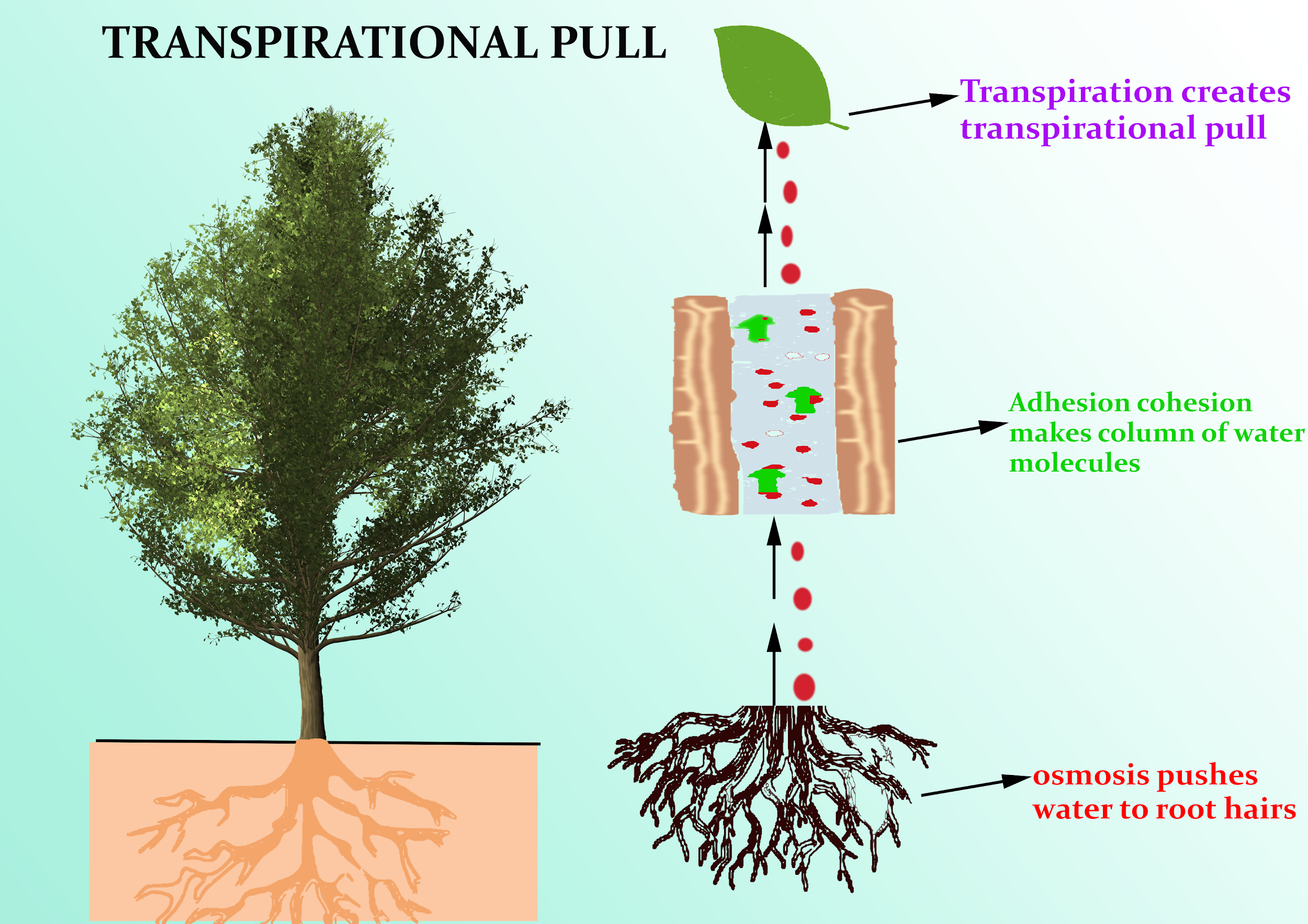
Explain the transpiration pull theory for the ascent of sap.
Answer
580.5k+ views
Hint: It is also known as the cohesion-tension theory or cohesion hypothesis. It is mainly based on properties of water molecules, xylem vessels, and forces created due to transpiration. It is a passive process.
Complete answer:
The transpirational pull is the major factor responsible for the absorption of water in plants. The absorption force develops in the shoot or aerial parts of the plant due to the evaporation of water from these surfaces. It is the most rapid method of water absorption in plants and 98% water absorption occurs by this method.
Additional Information:
Transpiration Pull:
A pulling force develops due to transpiration in the xylem column and this is known as transpirational pull. Evaporation of water occurs from the intercellular spaces in leaves, this vacancy of water if filled by mesophyll cells which release more water into the intercellular spaces. Mesophyll cells obtain this water from xylem vessels. Due to this, a tension is created in the water column in the xylem of leaves and this tension extends throughout the whole xylem vessel up to the xylem of roots. This now causes the water to move upwards to the leaves and the whole water column acts as a rope that cannot be broken. So the transpirational pull results in pulling of this rope upwards and to maintain a continuous water column more water gets absorbed by the soil passively by diffusion. Two pathways of water are present, symplast and apoplast.
Cohesion and Adhesion:
This continuous chain of water molecules is maintained due to the cohesion and adhesion forces. The attractive forces that exist between water molecules are known as cohesive forces, this is mainly due to the hydrogen bonds existing between water molecules. The adhesive forces refer to the attraction between water molecules and the wall of xylem vessels.

Note: One problem may arise during the ascent of sap due to transpirational pull, which is the presence of air bubbles which can break the continuous chain of the water column. This is especially seen in larger vessels. When the amount of tension generated is too high then vessels get filled with air bubbles and this phenomenon is known as cavitation. This problem is solved as many vessel columns are present side by side and therefore harmful effects of cavitation are eliminated.
Complete answer:
The transpirational pull is the major factor responsible for the absorption of water in plants. The absorption force develops in the shoot or aerial parts of the plant due to the evaporation of water from these surfaces. It is the most rapid method of water absorption in plants and 98% water absorption occurs by this method.
Additional Information:
Transpiration Pull:
A pulling force develops due to transpiration in the xylem column and this is known as transpirational pull. Evaporation of water occurs from the intercellular spaces in leaves, this vacancy of water if filled by mesophyll cells which release more water into the intercellular spaces. Mesophyll cells obtain this water from xylem vessels. Due to this, a tension is created in the water column in the xylem of leaves and this tension extends throughout the whole xylem vessel up to the xylem of roots. This now causes the water to move upwards to the leaves and the whole water column acts as a rope that cannot be broken. So the transpirational pull results in pulling of this rope upwards and to maintain a continuous water column more water gets absorbed by the soil passively by diffusion. Two pathways of water are present, symplast and apoplast.
Cohesion and Adhesion:
This continuous chain of water molecules is maintained due to the cohesion and adhesion forces. The attractive forces that exist between water molecules are known as cohesive forces, this is mainly due to the hydrogen bonds existing between water molecules. The adhesive forces refer to the attraction between water molecules and the wall of xylem vessels.

Note: One problem may arise during the ascent of sap due to transpirational pull, which is the presence of air bubbles which can break the continuous chain of the water column. This is especially seen in larger vessels. When the amount of tension generated is too high then vessels get filled with air bubbles and this phenomenon is known as cavitation. This problem is solved as many vessel columns are present side by side and therefore harmful effects of cavitation are eliminated.
Recently Updated Pages
Master Class 11 Economics: Engaging Questions & Answers for Success

Master Class 11 English: Engaging Questions & Answers for Success

Master Class 11 Social Science: Engaging Questions & Answers for Success

Master Class 11 Biology: Engaging Questions & Answers for Success

Class 11 Question and Answer - Your Ultimate Solutions Guide

Master Class 11 Business Studies: Engaging Questions & Answers for Success

Trending doubts
What is meant by exothermic and endothermic reactions class 11 chemistry CBSE

10 examples of friction in our daily life

One Metric ton is equal to kg A 10000 B 1000 C 100 class 11 physics CBSE

Difference Between Prokaryotic Cells and Eukaryotic Cells

What are Quantum numbers Explain the quantum number class 11 chemistry CBSE

1 Quintal is equal to a 110 kg b 10 kg c 100kg d 1000 class 11 physics CBSE




